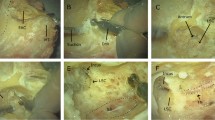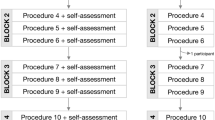Abstract
Purpose
Ultra-high-fidelity (UHF) graphics in virtual reality (VR) simulation might improve surgical skill acquisition in temporal bone training. This study aims to compare UHF VR simulation training with conventional, screen-based VR simulation training (cVR) with respect to performance and cognitive load (CL).
Methods
In a randomized trial with a cross-over design, 24 students completed a total of four mastoidectomies in a VR temporal bone surgical simulator: two performances under UHF conditions using a digital microscope and two performances under conventional conditions using screen-based VR simulation. Performances were assessed by two blinded raters using an established assessment tool. In addition, CL was estimated as the relative change in secondary-task reaction time during simulation when compared with individual baseline measurements. Data were analyzed using linear mixed model analysis for repeated measurements.
Results
The mean final-product performance score was significantly lower in UHF VR simulation compared to cVR simulation [mean difference 1.0 points out of 17 points, 95% CI (0.2–1.7), p = 0.02]. The most important factor for performance during UHF simulation was the ability to achieve stereovision (mean difference = 3.4 points, p < 0.001). Under the UHF VR condition, CL was significantly higher than during cVR (28% vs. 18%, respectively, p < 0.001).
Conclusion
UHF graphics in VR simulation training reduced performance and induced a higher CL in novices than conventional, screen-based VR simulation training. Consequently, UHF VR simulation training should be preceded by cVR training and might be better suited for the training of intermediates or experienced surgeons.




Similar content being viewed by others
References
George AP, De R (2010) Review of temporal bone dissection teaching: How it was, is and will be. J Laryngol Otol 124(2):119–125
Frithioff A, Sørensen MS, Andersen SAW (2018) European status on temporal bone training: a questionnaire study. Eur Arch Otorhinolaryngol 275(2):357–363
Wiet GJ, Sørensen MS, Andersen SAW (2017 Oct) Otologic skills training. Otolaryngol Clin N Am 50(5):933–945
Kashikar TS, Kerwin TF, Moberly AC, Wiet GJ (2019) A review of simulation applications in temporal bone surgery. Laryngoscope Investig Otolaryngol 4:420–424
Zhao YC, Kennedy G, Yukawa K, Pyman B, O'Leary S (2011) Can virtual reality simulator be used as a training aid to improve cadaver temporal bone dissection? Results of a randomized blinded control trial. Laryngoscope 121(4):831–837
Wiet GJ, Stredney D, Kerwin T et al (2012) Virtual temporal bone dissection system: OSU virtual temporal bone system. Laryngoscope 122(S1):S1–S12
Andersen SAW, Foghsgaard S, Caye-Thomasen P, Sørensen MS (2018) The effect of a distributed virtual reality simulation training program on dissection mastoidectomy performance. Otol Neurotol 39(10):1277–1284
Andersen SAW, Foghsgaard S, Konge L, Caye-Thomasen P, Sørensen MS (2016) The effect of self-directed virtual reality simulation on dissection training performance in mastoidectomy. Laryngoscope 126(8):1883–1888
Frederiksen JG, Sørensen MS, D, Konge L, Bo M, Svendsen S, et al (2019) Cognitive load and performance in immersive virtual reality versus conventional virtual simulation training of laparoscopic surgery: a randomized trial. Surg. Endosc. https://doi.org/10.1007/s00464-019-06887-8
Dargar S, Kennedy R, Lai W, Arikatla V, De S (2015) Towards immersive virtual reality (IVR): a route to surgical expertise. J Comput Surg 2:2
Alaraimi B, El Bakbak W, Sarker S, Makkiyah S, Al-Marzouq A, Goriparthi R et al (2014) A randomized prospective study comparing acquisition of laparoscopic skills in three-dimensional (3D) vs. two-dimensional (2D) laparoscopy. World J Surg 38(11):2746–2752
Harada H, Kanaii S, Hasegawa H, Yamamoto M, Matsuda Y (2018) The effect on surgical skills of expert surgeons using 3D / HD and 2D / 4K resolution monitors in laparoscopic phantom tasks. Surg Endosc 32(10):4228–4234
Huber T, Paschold M, Hansen C, Wunderling T, Lang H, Kneist W (2017) New dimensions in surgical training: immersive virtual reality laparoscopic simulation exhilarates surgical staff. Surg Endosc Other Interv Tech 31(11):4472–4477
Pulijala Y, Ma M, Pears M, Peebles D, Ayoub A (2018) Effectiveness of immersive virtual reality in surgical training: a randomized control trial. J Oral Maxillofac Surg 76(5):1065–1072
Van Merriënboer JJG, Sweller J (2010) Cognitive load theory in health professional education: Design principles and strategies. Med Educ 44(1):85–93
Andersen SAW, Mikkelsen PT, Konge L, Cayé-Thomasen P, Sørensen MS (2016) Cognitive load in mastoidectomy skills training: virtual reality simulation and traditional dissection compared. J Surg Educ 73(1):45–50
Andersen SAW, Caye-Thomasen P, Sorensen MS (2015) Mastoidectomy performance assessment of virtual simulation training using final-product analysis. Laryngoscope 125(2):431–435. https://doi.org/10.1002/lary.24838
Naismith L, Cavalcanti R (2015) Validity of cognitive load measures in simulation-based training: a systematic review. Acad Med 90(11):S24–S35
Andersen SAW, Mikkelsen PT, Konge L (2016) Cognitive load in distributed and massed practice in virtual reality mastoidectomy simulation. Laryngoscope 126(1):74–79
Leppink J (2015) Data analysis in medical education research: a multilevel perspective. Perspect Med Educ 4(1):14–24
Haji FA, Cheung JJH, Woods N, Regehr G, de Ribaupierre S, Dubrowski A (2016) Thrive or overload? The effect of task complexity on novices’ simulation-based learning. Med Educ 50(9):955–968
Nibourg LM, Wanders W, Cornelissen FW, Koopmans SA (2015) Influence of stereoscopic vision on task performance with an operating micoscope. J Cart Refract Surg 41(9):1919–1925
Hamstra SJ, Brydges R, Hatala R, Zendejas B, Cook DA (2014) Reconsidering fidelity in simulation-based training. Acad Med 89(3):387–392
Allen J, Buffardi L, Hays R (1991) The relationship of simulator fidelity to task and performance variables George Mason Univ Fairfax VA, Dept of Psychology.
Frendø M, Thingaard E, Konge L, Sølvsten M, Andersen S (2019) Decentralized virtual reality mastoidectomy simulation training: a prospective, mixed-methods study. Eur Arch Otorhinolaryngol 276(10):2783–2789
Acknowledgements
We would like to acknowledge ARRI Medical (Munich, Germany) for lending us the ARRISCOPE oculars for digital projection.
Funding
The authors received no specific funding for this work.
Author information
Authors and Affiliations
Corresponding author
Ethics declarations
Conflict of interest
The authors declare that they have no conflict of interest.
Ethical approval
The regional ethical committee of the capital region of Denmark found this educational trial exempted (H-180042355).
Informed consent
Written consent was obtained from all the participants included in the study.
Additional information
Publisher's Note
Springer Nature remains neutral with regard to jurisdictional claims in published maps and institutional affiliations.
Rights and permissions
About this article
Cite this article
Frithioff, A., Frendø, M., Mikkelsen, P.T. et al. Ultra-high-fidelity virtual reality mastoidectomy simulation training: a randomized, controlled trial. Eur Arch Otorhinolaryngol 277, 1335–1341 (2020). https://doi.org/10.1007/s00405-020-05858-3
Received:
Accepted:
Published:
Issue Date:
DOI: https://doi.org/10.1007/s00405-020-05858-3




